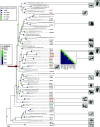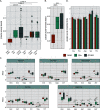Coevolutionary Analysis Implicates Toll-Like Receptor 9 in Papillomavirus Restriction
- PMID: 35311536
- PMCID: PMC9040848
- DOI: 10.1128/mbio.00054-22
Coevolutionary Analysis Implicates Toll-Like Receptor 9 in Papillomavirus Restriction
Abstract
Upon infection, DNA viruses can be sensed by pattern recognition receptors (PRRs), leading to the activation of type I and III interferons to block infection. Therefore, viruses must inhibit these signaling pathways, avoid being detected, or both. Papillomavirus virions are trafficked from early endosomes to the Golgi apparatus and wait for the onset of mitosis to complete nuclear entry. This unique subcellular trafficking strategy avoids detection by cytoplasmic PRRs, a property that may contribute to the establishment of infection. However, as the capsid uncoats within acidic endosomal compartments, the viral DNA may be exposed to detection by Toll-like receptor 9 (TLR9). In this study, we characterized two new papillomaviruses from bats and used molecular archeology to demonstrate that their genomes altered their nucleotide compositions to avoid detection by TLR9, providing evidence that TLR9 acts as a PRR during papillomavirus infection. Furthermore, we showed that TLR9, like other components of the innate immune system, is under evolutionary selection in bats, providing the first direct evidence for coevolution between papillomaviruses and their hosts. Finally, we demonstrated that the cancer-associated human papillomaviruses show a reduction in CpG dinucleotides within a TLR9 recognition complex. IMPORTANCE Viruses must avoid detection by the innate immune system. In this study, we characterized two new papillomaviruses from bats and used molecular archeology to demonstrate that their genomes altered their nucleotide compositions to avoid detection by TLR9, providing evidence that TLR9 acts as a PRR during papillomavirus infection. Furthermore, we demonstrated that TLR9, like other components of the innate immune system, is under evolutionary selection in bats, providing the first direct evidence for coevolution between papillomaviruses and their hosts.
Keywords: Mexican free-tailed bat; Papillomaviridae; TLR9; evolutionary biology; innate immunity; papillomavirus; speciation.
Conflict of interest statement
The authors declare no conflict of interest.
Figures








Similar articles
-
Toll-like receptor 9-mediated protection of enterovirus 71 infection in mice is due to the release of danger-associated molecular patterns.J Virol. 2014 Oct;88(20):11658-70. doi: 10.1128/JVI.00867-14. Epub 2014 Jul 30. J Virol. 2014. PMID: 25078697 Free PMC article.
-
TLR9 expression and function is abolished by the cervical cancer-associated human papillomavirus type 16.J Immunol. 2007 Mar 1;178(5):3186-97. doi: 10.4049/jimmunol.178.5.3186. J Immunol. 2007. PMID: 17312167
-
Selective evolution of Toll-like receptors 3, 7, 8, and 9 in bats.Immunogenetics. 2017 Apr;69(4):271-285. doi: 10.1007/s00251-016-0966-2. Epub 2016 Dec 24. Immunogenetics. 2017. PMID: 28013457 Free PMC article.
-
Antiviral signaling through pattern recognition receptors.J Biochem. 2007 Feb;141(2):137-45. doi: 10.1093/jb/mvm032. Epub 2006 Dec 26. J Biochem. 2007. PMID: 17190786 Review.
-
TLR9: A friend or a foe.Life Sci. 2022 Oct 15;307:120874. doi: 10.1016/j.lfs.2022.120874. Epub 2022 Aug 10. Life Sci. 2022. PMID: 35963302 Review.
Cited by
-
Complete Genomes of DNA Viruses in Fecal Samples from Small Terrestrial Mammals in Spain.Viruses. 2024 Dec 5;16(12):1885. doi: 10.3390/v16121885. Viruses. 2024. PMID: 39772193 Free PMC article.
-
Regulation of the Innate Immune Response during the Human Papillomavirus Life Cycle.Viruses. 2022 Aug 17;14(8):1797. doi: 10.3390/v14081797. Viruses. 2022. PMID: 36016419 Free PMC article. Review.
-
CpG 684: an effective adjuvant for the inactivated COVID-19 vaccine in mice.Future Virol. 2023 May;18(7):403-410. doi: 10.2217/fvl-2022-0172. Epub 2023 Jun 1. Future Virol. 2023. PMID: 38051998 Free PMC article.
-
Insight into the codon usage patterns and adaptation of Tembusu Virus.Poult Sci. 2025 Jan;104(1):104651. doi: 10.1016/j.psj.2024.104651. Epub 2024 Dec 7. Poult Sci. 2025. PMID: 39667183 Free PMC article.
-
Discovery of three cycloviruses in fecal samples from silver-haired bats (Lasionycteris noctivagans) in Arizona (USA).Arch Virol. 2022 Dec;167(12):2771-2775. doi: 10.1007/s00705-022-05574-9. Epub 2022 Aug 31. Arch Virol. 2022. PMID: 36045303 Free PMC article.
References
MeSH terms
Substances
Grants and funding
LinkOut - more resources
Full Text Sources
Medical

